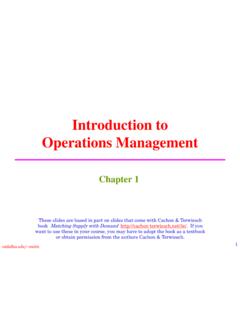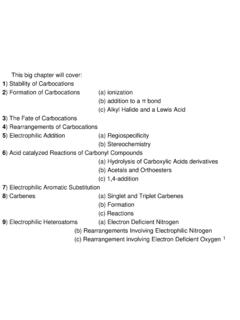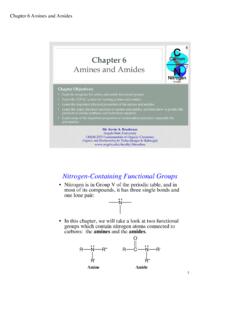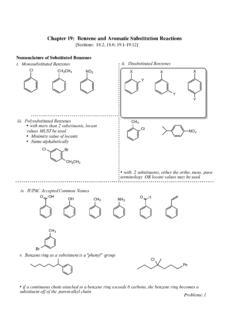Transcription of OXIDATION AND REDUCTION IN ORGANIC CHEMISTRY
1 OXIDATION AND REDUCTION IN ORGANIC CHEMISTRYIn ionic and free radical reactions , OXIDATION and REDUCTION are defined as processes by which an elementundergoes a net loss or gain of electrons, respectively. The concept as applied to ORGANIC covalent compounds,where elements share electrons rather than losing or gaining them is the same, but it s frequently simplifiedand narrowed down to make it easier to recognize these processes. Therefore it must be kept in mind that,while the following definition is grossly simplified, it serves the goal of quickly identifying OXIDATION andreduction processes in many ORGANIC reference to ORGANIC molecules, OXIDATION is a process by which a carbon atom gains bonds to moreelectronegative elements, most commonly oxygen. REDUCTION is a process by which a carbon atom gainsbonds to less electronegative elements, most commonly following chart summarizes these concepts when applied to ORGANIC transformations.
2 [ox] stands foroxidation, and [red] stands for (CO2)alkanealcoholaldehydecarboxylicacid carbondioxideMosthighlyreducedstateMosth ighlyoxidizedstate[ox][red][ox][red][ox] [red][ox][red]OXIDATIONREDUCTIONSome points must be noted. First, a gain or loss of bonds means simply more or less bonds. The double bondcounts as two bonds and the triple bond counts as three bonds. Thus in the carbonyl group (C=O) carbonis considered to have two bonds to oxygen. Therefore, this carbon has a higher OXIDATION state than thealcohol carbon, which has only one bond to oxygen. In routine terminology, it is said that the aldehyde isa more highly oxidized functional group than the alcohol. OXIDATION reactions are therefore those in whichthe central carbon of a functional group is transformed into a more highly oxidized form, and reductionreactions are those in which the central carbon is transformed into a more highly reduced , there can be several functional groups where the central carbon has the same OXIDATION state.
3 Forexample, the carbons bonded to oxygen in alcohols and ethers have the same OXIDATION state. Likewise foraldehydes and their hydrated forms, and for carboxylic acids and their derivatives . However, most referencesto OXIDATION and REDUCTION reactions in ORGANIC CHEMISTRY textbooks involve the functional groups presentedin the chart chart presented before shows the OXIDATION and REDUCTION states for a molecule that contains only onecarbon. But most ORGANIC compounds contain more than one carbon. The maximum OXIDATION state that aparticular carbon can attain depends on how many other carbons it must remain attached to. For example,a molecule with two carbon atoms could not be oxidized all the way to carbon dioxide because the carbonatom in CO2 must have four bonds to oxygen, leaving no room for bonds to other carbons. The maximumoxidation state that a carbon can attain decreases gradually as the number of bonds to other carbonsincreases.
4 Thus, the maximum OXIDATION state possible for a carbon that s bonded to one other carbon isthe carboxylic acid stage, and so on. The following chart illustrates this (methane)alcoholaldehydecarboxylicacidca rbondioxide(CO2)ONESINGLECARBON[ox][red] [ox][red][ox][red][ox][red]CARBONBONDEDT OONEOTHERCARBONCHHHH3 CCHHOHH3CH3 CCHOH3 CCOHO alkane(1ocarbon)1oalcoholaldehydecarboxy licacid[ox][red][ox][red][ox][red]CARBON BONDEDTOTWOOTHERCARBONSCHHCH3H3 CCOHHCH3H3CH3 CCCH3 Oalkane(2ocarbon)2oalcoholketone[ox][red ][ox][red]CCH3 HCH3H3 CCCH3 OHCH3H3C3oalcohol[ox][red]alkane(3ocarbo n)CARBONBONDEDTOTHREEOTHERCARBONS
















